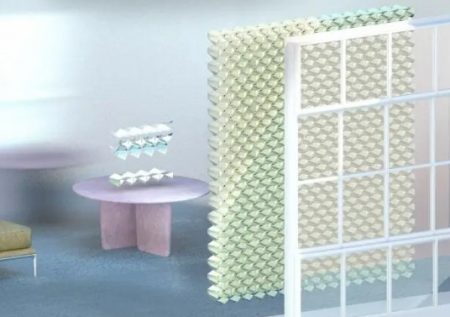February 23, 2019 – Prevalent, a New South Wales, Australia-based architectural firm has come up with a design for an origami solar blind that enhances light entering a building while generating electricity. Called Solgami (patent pending), the technology replaces normal window coverings. And because it has the fold-like characteristics of origami, it creates a range of angled surfaces to convey light into an interior space at all times of day while, at the same time, capturing the energy from the photons and converting it to electricity.
Prevalent first conceived of the idea in a project it called the Digital Garden. The firm looked at where most people in the world live today – in cities, and in multi-tenanted buildings. As architects, Prevalent knew that one thing apartment dwellers crave is natural light as a priority when choosing a place to live. So it began to come up with a way to bring more light into building interiors while at the same time committing itself to its climate change mission of promoting renewable energy power generation.
I have written about transparent solar cells that can be applied to windows, and even about turning slats in Venetian blinds into solar power generators. But what Prevalent is designing is far more elegant and effective. Creating a geometrically pleasing lattice that enfolds on itself and opens to collect light and bring it into the interior of an apartment while harvesting energy from the light is a novel concept. And then designing the lattice to present itself in multiple configurations for different appearance and effect while continuing to channel changing light throughout the day, makes Solgami a unique renewable energy-lighting solution.
The current prototype is a screen lattice about 50 millimeters in depth that can be hung just like a window blind. The blind is flexible to take on various honeycomb shapes as the user folds and unfolds it. The material contains diosensitized solar cells (DSSCs). It folds accordion-like in one direction while rotating elbow-like in another which allows it to reflect light captured at varying times of the day. The light that enters the window reflects off the lattice surfaces with more bounces yielding more energy.
The current manufacturing process prints blind components in rows which then get folded into the lattice shape. Prevalent is using a Japanese partner to produce its first large-scale prototypes. Smaller scale versions are in the planning stage for almost any window treatment.
For glass skyscrapers, Solgami blinds would potentially allow a building to become electricity self-sufficient while the enhanced natural light would cut down on the use of lighting fixtures. Prevalent envisages buildings generating surplus power from Solgami blinds and sending it to neighbouring buildings or to the power grid.
















